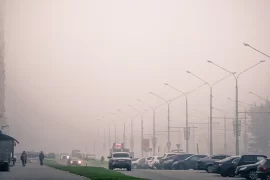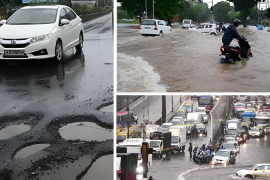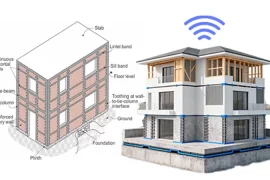
Build Green, Breathe Clean: Protect Tricity Homes from Diwali and Crop-Burning Smog
Every autumn, residents of Tricity brace for a recurring threat – a dense, choking haze that blankets the area. The deadly combination of Diwali fireworks and Parali (crop stubble) burning across Punjab and Haryana is causing this smog – which is not just the result of the celebrations. When fog and dust are added – the result is smog, a poisonous mixture of air that poses a threat to both comfort and health.
The Tribune reports that Chandigarh’s Air Quality Index (AQI) often reaches extremely low levels around Diwali, with PM2.5 concentrations approaching 700 µg/m³, which is much above the acceptable limit. NASA and ISRO satellite imagery supports what locals already know: large-scale Parali burning in nearby agricultural belts is the primary source of much of this pollution.
The Impact of Crop Burning on Tricity’s Air
After every harvest, large-scale Parali (crop residue) burning in Punjab and Haryana releases harmful gases and fine particles into the air. These pollutants drift toward Chandigarh, Mohali, and Panchkula, worsening smog levels after Diwali. With calm winds and low temperatures, the smoke mixes with local emissions, trapping toxic air over the region. Studies show that around 40% of Tricity’s post-Diwali pollution comes from stubble burning — a major reason why cleaner, pollution-resistant homes are now essential for healthier living.

Why Tricity Homes Need Smart Defense
The months of October through November usually see the highest levels of smog in Chandigarh, Mohali, and Panchkula. The air thickens with tiny particles and smoke during this period, causing eyes to sting, throats to burn and visibility to decrease. However, a lot of people forget that this toxic outdoor air doesn’t stay outside. Families spend up to 90% of their time indoors, where the quality of the air is deteriorated by fine particles that enter through windows, doors, and ventilation systems.
For this reason, the focus on modern, eco-friendly homes in Tricity is shifting from aesthetics to resilience. The goal is simple: create buildings that shield residents from pollution while ensuring constant supply of breathing, clean indoor air.
Smart Construction Solutions for Cleaner Air
Seal the Gaps, Lock Out Pollution
Proper sealing is the first step in designing a home that is resistant to pollution. Smoke particles are kept out by installing weather stripping around windows and doors. Double-glazed windows increase energy efficiency while adding more protection against outdoor pollutants.
Installing high-quality window seals and door sweeps are small additions that have a big impact on days – with a lot of smog.
Strategic Ventilation for Fresh Air
To eliminate fine particles (PM2.5) from indoor air, install HEPA air purifiers or filter-equipped mechanical ventilation systems. When cooking or taking a shower, use exhaust fans in the kitchen and bathroom. Open windows to release stale indoor air when the outside air briefly clears, which is usually midday or after rain. Otherwise, rely on filtered circulation and keep windows closed.
Natural Solutions That Work
Indoor plants purify the air naturally. NASA’s clean-air study highlights practical solutions for homes in the Tricity:
- Aloe Vera: Filters benzene and other chemicals; requires minimal care.
- Peace Lilies: Fight off ammonia and benzene (keep away from pets).
- Snake Plants: Eliminate formaldehyde and xylene; and can withstand low light levels.
- Boston Ferns: Remove formaldehyde and grow well in moist environments
For the best air cleaning place two to three plants per 100 square feet. Residents of Tricity love these air-purifying plants since they actively filter indoor air – while also adding an aesthetic appeal.
Advanced Home Protection Tips
During peak pollution season:
- Only open windows in the early morning (5-7 AM), when pollution levels are usually lower.
- Keep indoor humidity between 40 and 50 percent to prevent smoke infiltration.
- Use damp cloths near entry points to trap dust particles.
- Create no-shoe policies and heavy-duty entrance mats.

Dust-Proof Your Tricity Home
In high-traffic areas, choose washable fabrics, smooth surfaces over textured ones and ceramic tiles over carpets. Make use of furniture that emits fewer irritants and low-VOC paints and adhesives.
Weekly deep cleaning, monthly HVAC filter replacements, and proper sealing of cracks around windows, doors, and electrical outlets are all examples of routine maintenance.
Building Tomorrow: Sustainable Solutions
When planning renovations or new construction, consider materials that contribute to better indoor air quality. Healthy living environments can be created by using natural materials like bamboo flooring, proper insulation, and green materials that have been approved by respected authority.
Install smart AQI sensors that activate purifiers automatically when necessary, and position windows to catch the prevailing winds on days with low smog.
Expert Guidance for Healthier Homes
Low VOC materials, high quality insulation and airtight construction are all healthy components of pollution resistant homes. While natural materials and innovative designs promote fresh air and sustainability, advanced ventilation and filtration systems help reduce indoor pollutants. For a safe, more comfortable living environment, it can be helpful to tailor a solution to local environmental concerns by consulting experienced builders or air quality experts.
Your Health Sanctuary Awaits
This Diwali season, smart home designs that minimize pollution exposure are about making thoughtful construction choices that prioritize the health of the family first – not about spending on expensive gadgets. The health of your family is improved with every step you take to create a pollution-resistant home.
Are you ready to make your home healthier and cleaner? Speak with construction experts who have expertise about Tricity’s unique environmental challenges and who can help you find solutions that fit your needs and budget.
Frequently Asked Questions (FAQs)
-
Why does air quality in Chandigarh and Tricity drop after Diwali?
After Diwali, the combination of firecracker smoke, crop residue burning in Punjab & Haryana, and stagnant winter air traps pollutants — leading to severe smog across Tricity.
-
What is the impact of crop burning on Tricity’s air quality?
Crop burning releases large amounts of PM2.5 and toxic gases, which drift toward Chandigarh, Mohali, and Panchkula, drastically reducing air quality and visibility.
-
How harmful is Diwali smog for health?
Diwali smog can cause breathing issues, eye irritation, coughing, and worsen asthma or heart conditions. It’s especially dangerous for children and the elderly.
-
What steps can Tricity residents take during smog season?
Residents should use air purifiers, wear N95 masks outdoors, avoid burning waste, and ventilate homes only when pollution levels drop — usually early morning or after rain.
-
How can people celebrate Diwali without worsening air quality?
Choose green crackers, LED diyas, or laser light shows instead of fireworks. Plant trees and spread awareness for a cleaner, safer Diwali in Tricity.






